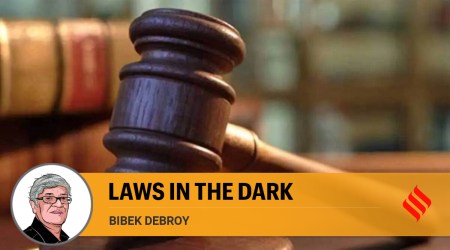In Leh, how a government school is helping a small village win big battle
ON MARCH 7, the Government Middle School in Taru village, about 25 km from Leh city, opened its doors after three years to welcome 21 students. It was the first step back to life — for the school and the village.
“In 2019, when the school was on the verge of closing, having enrolled just five students, we organised several meetings, calling parents, the sarpanch and the local youth association. We wanted to tell the parents to not take their children away to private schools. But instead of parents, the grandparents turned up. The parents had already moved to Leh city,” said Sonam Chorol, the school principal.
According to local residents, the village’s fortune is tied to that of the school. Over the past few years, they said, most parents of school going children in the village of about 500 people had shifted to Leh, preferring private schools. As a result, the four teachers at the local school were shifted to other government schools and offices around Leh.
“The village was left with mostly grandparents. There was a government primary school, which was shut down over 15 years ago. The middle school was established in 1955, and had the highest enrollment in 1995 of 60-65 students,” said Tsering Angdus, a senior teacher who was posted in this school from 1995-98.
The turning point came this year when local youths joined hands with the newly established University of Ladakh at Taru Thang, near the village.
“We have supported them as much as possible. Two university staffers have been deployed as kindergarten teachers. We have provided the university bus, too, to fetch students to the school,” said the university’s Vice Chancellor Prof S K Mehta.
Local residents chipped in by joining hands to renovate the school building. But the big challenge, according to Taru Youth Association president Sonam Angchok, was the “mindset” of parents.
“With help from the university, we made them understand the importance of education at the doorstep. We made them realise that this school is ours and we have to make it alive again. We made them aware of the new facilities provided in government schools,” said Angchok, who teaches maths at the school.
According to Angchok, the parents had shifted their children to private schools in Leh due to the availability of infrastructure and technology like smart classrooms, tablets and computers along with CBSE education.
“But now, the government has started providing smart classrooms in a phased manner. We have been assured that in the coming months, these will be provided to our school, too. The local youth society has donated study material and helped in renovation. We also involved the parents in redeveloping and restructuring the school so there is a sense of belonging,” Angchok said.
With classes sanctioned upto to class 8, the Taru middle school currently has 11 students in the nursery classroom, one in LKG, three in UKG, one each in class 1, 2, 3 and 4, and two in Class 6. With more families now planning to return, the school is expecting enrollment to reach 40 before winter. The staff strength has already risen to seven: four teaching staff and a Physical Education teacher, apart from the two contract teachers deployed by the university.
“Now, government schools in Ladakh are affiliated to the CBSE and not the J&K State Board. The system is good and the teachers are also good here,” Stenzin Phalgais, who has enrolled his five-year-old son in the UKG section of the Taru school, said.
“I am very happy that my grandchildren are back with me,” said 95-year-old Sonam Yangzes whose twin granddaughters were shifted from a private school in Leh and are now the only students in Class 6 at the Taru school.
“It was heartbreaking to see our sons and daughters leave for their children’s education. The grandparents were left behind to look after the land. Let us hope that with this school reopening, everything will return to how it was,” Sonam Spalzes, a 96-year-old local resident, said.
Ladakh’s Director of School Education, Safdar Ali, marked the introduction of CBSE in government schools as a key step. “From this academic session, there has been an increase in enrollment in government schools. Also, the central TET (Teachers Eligibility Test) has been made mandatory. Such initiatives have changed the perception of government schools in Ladakh,” he said.
According to official figures, the new Union Territory has around 28,000 students in nearly 900 government schools.
Referring to Taru, Ali said the government will chip in with “special initiatives like immediate transfer of teachers, mid-day meal and ICDS (Integrated Child Development Services) coverage” — and “ensure toilet and hand-wash facilities”.
“With the collective effort of villagers and the university, the school was reopened after three years,” University of Ladakh’s Leh campus director Konchok Angmo, who hails from Taru, said.
The final twist? The toys and other material for KG students were procured from a private playschool in Leh that was shutting down. “When we heard about it, we rushed over and picked up all the stuff at reasonable rates,” Angchok, the youth leader, said.






